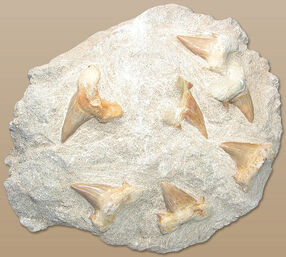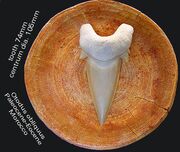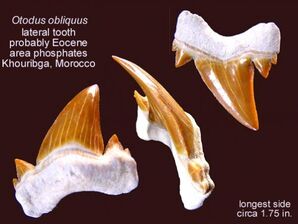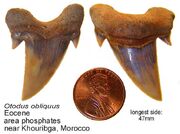
Otodus obliquus in original matrix
Otodus obliquus, previously known as Lamna obliqua was one of the earliest mackerel sharks. Their teeth are noted for their wide triangular crown and large side cusps (occasionally multiple side cusps). Large Otodus obliquus teeth are not easily located in the phosphate pits in Atlas Mountains of Morocco, but can still be affordable. Most teeth are destroyed when collected due to the crude extraction techniques. Otodus obliquus ruled the ocean's during the Early Eocene and Paleocene epochs - (approx. 60-45 million years ago).
Fossils[]
This genus (and other family taxa) is known from isolated and/or associated teeth and vertebrae. The teeth are triangular in shape, bear (usually large) triangular and divergent lateral cusplets (occasionally more than one) and can be quite massive, with some teeth reaching sizes of 3.5 inches and larger.

Otodus tooth with vertebrate for comparison
Teeth[]
Most teeth teeth are destroyed when collected due to the crude extraction techniques. Most teeth will lose one or more side cusps and / or roots will break when extracted. These items are then be reattached. Most O. obliquus teeth on the market are poorly repaired.

Alternate views of an O. obliquus tooth.
This shark, previously called Lamna obliqua, is thought to be one of the earliest "giant" sharks. It may be the ancestor of most, if not all, living "Mackerel Sharks." The term "Mackerel Shark" refers to a type of shark, one with a particular body shape (like a fish - "Mackerel") and lifestyle (lives in the open water). The largest predatory shark that ever lived, the Megalodon, is thought to be one of the Otodus obliquus's descendants. One of the reasons the Megalodon is extinct may be that it was out-competed by its cousins, other Otodus obliquus descendants. Isurus hastalis is usually referred as the descendant of the Otodus lineage. Those descendants include the two current rulers of the open water, the Great White and Mako.
Localities
[]

O. obliquus tooth from Atlas Mountains.
A great many of the Otodus obliquus teeth available on the market today come from the Phosphate mines in the Atlas Mountains, near Khouribga, Morocco. They are thought to be from the Eocene/Paleocene (approximately 40-60 Million Years Old). Most of the teeth from Morocco have been "prepped" in the field, sometimes including significant repairs.
Distribution[]
Otodus obliquus is a widespread species, reported from the Danian (Early Paleocene) through Ypresian (Early Eocene) sediments of Africa, Asia, Europe & North America.
See Also[]
- Otodus-Carcharocles lineage
- Cretalamna-Otodus controversy